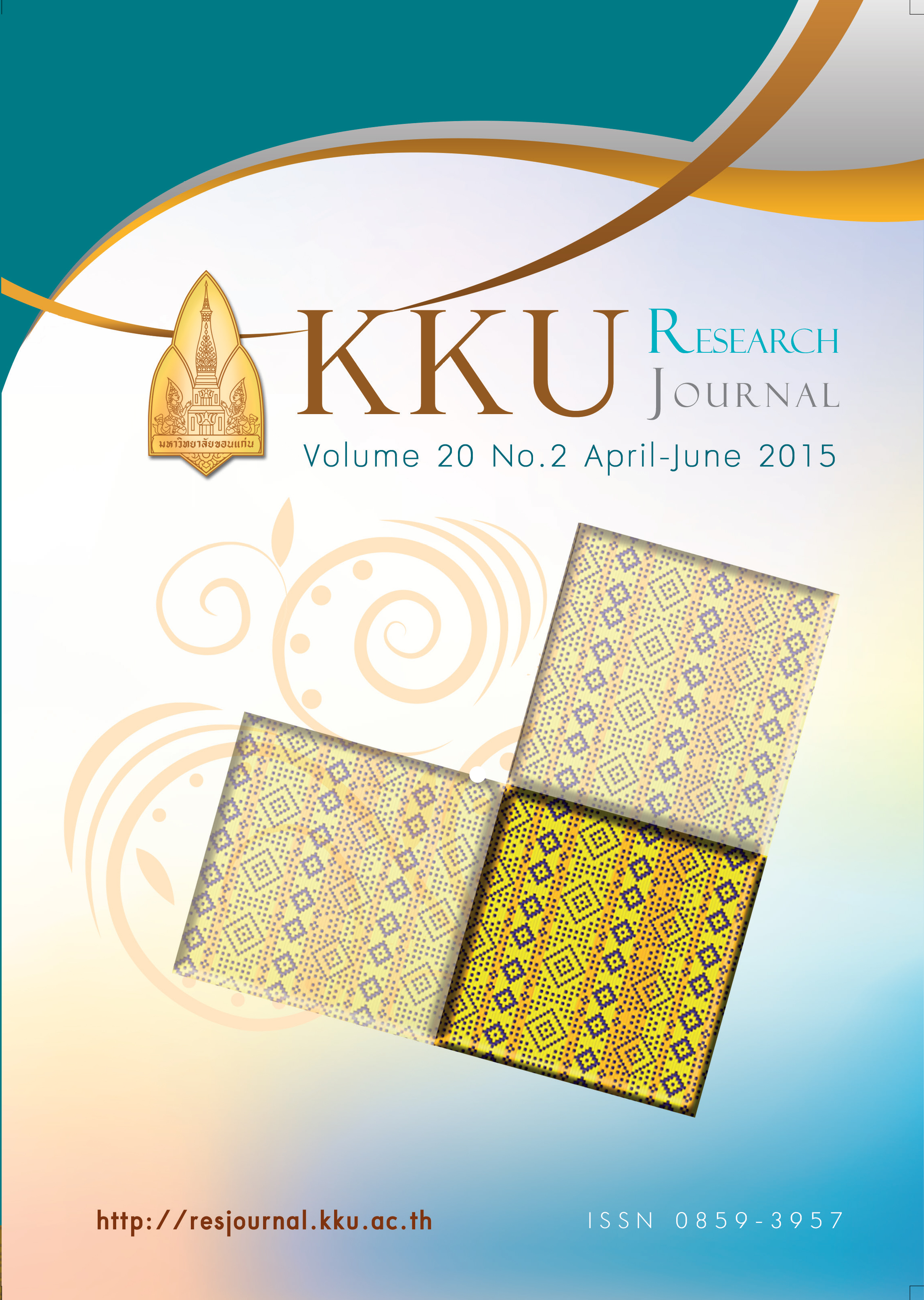Antioxidant and antibacterial activities of Indian marsh fleabane (Pluchea indica (L.) Less)
Main Article Content
Abstract
Ethanolic extracts of various parts of Pluchea indica (L.) Less were analyzed for DPPH radical scavenging capacities, total phenolic contents and antibacterial activities. The results showed that fresh root extract had the most antioxidant activities (0.16 0.001 mg/mL EC50, 20.02 0.177 mg/g TEAC and 15.79 0.008 mg GAE/g total phenolic content). Antioxidative activities of most fresh samples were significantly higher than that of dry samples (P < 0.05). The low antioxidative activities of dry samples might be due to the effect of drying (60 oC for 2 days). In contrast, tea leaves extract exhibited the high antioxidant capacities (0.28 0.012 mg/mL EC50, 11.86 0.519 mg/g TEAC and 3.18 0.012 mg GAE/g total phenolic content) due to the formation of Maillard reaction products during heating at lower temperature for a shorter period (50 oC for 2 hrs). Antibacterial activities assessed by the disc diffusion method showed that all of investigated bacteria were inhibited by the extract of fresh root, fresh twig, dry stem and tea leaves, while the extract of fresh and dry flower, fresh and dry leaves, and dry root showed the less inhibition potential. The minimal inhibitory concentrations (MICs) of extracts using agar microdilution and disc diffusion method showed significant inhibition activities even at 2 – 16 fold dilutions, with the most effective result in fresh root extract as low as 64 fold dilution. Tea leaves extract also had high inhibitory capacities when the concentrations were 4 - 16 fold dilution. Fresh root extract had the most excellent inhibition potential against Bacillus cereus, Pseudomonas fluorescens and Salmonella typhimurium (0.16, 0.16 and 0.32 mg/mL MICs, respectively). Inhibitory activities against Escherichia coli were very low. The increase in antioxidant activities did increase antibacterial abilities.
Article Details
References
[2] Andarwulan N, Batari R, Agustini D, Bolling B, Wijaya H. Flavonoid content and antioxidant activity of vegetables from Indonesia. Food Chemistry. 2010;121: 1231-1235.
[3] Ahemd SA, Kamel EM. Phenolic constituents and biological activity of the genus Pluchea. Der Pharma Chemica. 2013;5(5): 109-114.
[4] Noridayu AR, Hii YF, Faridah A, Khozirah S, Lajis N. Antioxidant and antiacetyl cholinesterase activities of Pluchea indica Less. International Food Research Journal. 2011;18(3): 925-928.
[5] Cho J, Cho CL, Kao CL, Chen CM, Tseng CN, Lee YZ, Liao LJ, Hong YR. Crude aqueous extracts of Pluchea indica (L.) Less. inhibit proliferation and migration of cancer cells through induction of P53-dependent cell death. Complementary and Alternative Medicine. 2012;12: 265.
[6] Dey A, Neth DJ. A survey of potential antiophidian botanicals from the baruipur sub-division of the district south 24 Parganas, West Bengal, India. International Journal of Medical Aromatic Plants. 2011;1(3): 219-227.
[7] Roslida A, Erazuliana A, Zuraini A. Anti-inflammatory and antinoci-ceptive activities of the ethanolic extract of Pluchea indica (L.) Less leaf. Pharmacologyonline. 2008;2: 349-360.
[8] Biswas R, Dutta PK, Achari B, Bandyopadhyay D, Mishra M, Pramanik KC, Chatterjee TK. Isolation of pure compound R/J/3 from Pluchea indica (L.) Less. and its anti-amoebic activities against Entamoeba histolytica. Phytomedicine. 2007;14: 534-537.
[9] Srisook K, Buapool D, Boonbai R, Simmasut P, Charoensuk Y, Srisook E. Antioxidant and anti-inflamma-tory activities of hot water extract from Pluchea indica Less. herbal tea. Journal of Medicinal Plants Research. 2012;6(23): 4077-4081.
[10] Shimada K, Fujikawa K, Yahara K, Nakamura T. Antioxidative properties of xanthan on the autoxidation of soybean oil in cyclodextrin emulsion. Journal of Agricultural and Food Chemistry. 1992;40(6): 945-948.
[11] Wong SP, Leong LP, Koh JHW. Antioxidant activities of aqueous extracts of selected plants. Food Chemistry. 2006;99: 775-783.
[12] Supa-in W. Identification of antibacterial compounds in twelve medicinal herbs. [MSc. Thesis]. Chiang Mai: Chiang Mai University; 2000. Thai.
[13] Jiang L. Comparison of disk diffu-sion, agar diffusion, agar dilution and broth microdilution for antimi-crobial susceptibility testing of five chitosans. [MSc. Thesis]. Louisi-ana: Louisiana State University; 2011.
[14] Larrauri JA, Rupérez P, Saura-Calixto F. Effect of drying tempera-ture on stability of polyphenols and antioxidant activity of red grape pomace peels. Journal of Agricul-tural Food Chemistry. 1997;45: 1390-1393.
[15] Aherne SA, O’Brien NM. Dietary flavonols: chemistry, food content, and metabolism. Nutrition. 2002;18: 75-81.
[16] Phisut N, Jiraporn B. Characteris-tics and antioxidant activity of Maillard reaction products derived from chitosan-sugar solution. International Food Research Journal. 2013;20(3): 1077-1085.
[17] Siddhuraju P, Manian S. The antioxidant activity and free radical scavenging capacity of dietary phenolic extracts from horse gram (Macrotyloma uniflorum (Lam.) Verdc.) seeds. Food Chemistry. 2007;105: 950-958.
[18] Maurya S, Singh D. Quantitative analysis of total phenolics content in Adhatoda vasica nees extracts. International Journal of Pharmaceu-tical Technology Research. 2010;2(4): 2403-2406.
[19] Andarwulan N, Kurniasih D, Apriady RA, Rahmat H, Roto AV, Bolling BW. Polyphenols, carotenoids, and ascorbic acid in underuitilized medicinal vegetables. Journal of Functional Food. 2012;4: 339-347.


